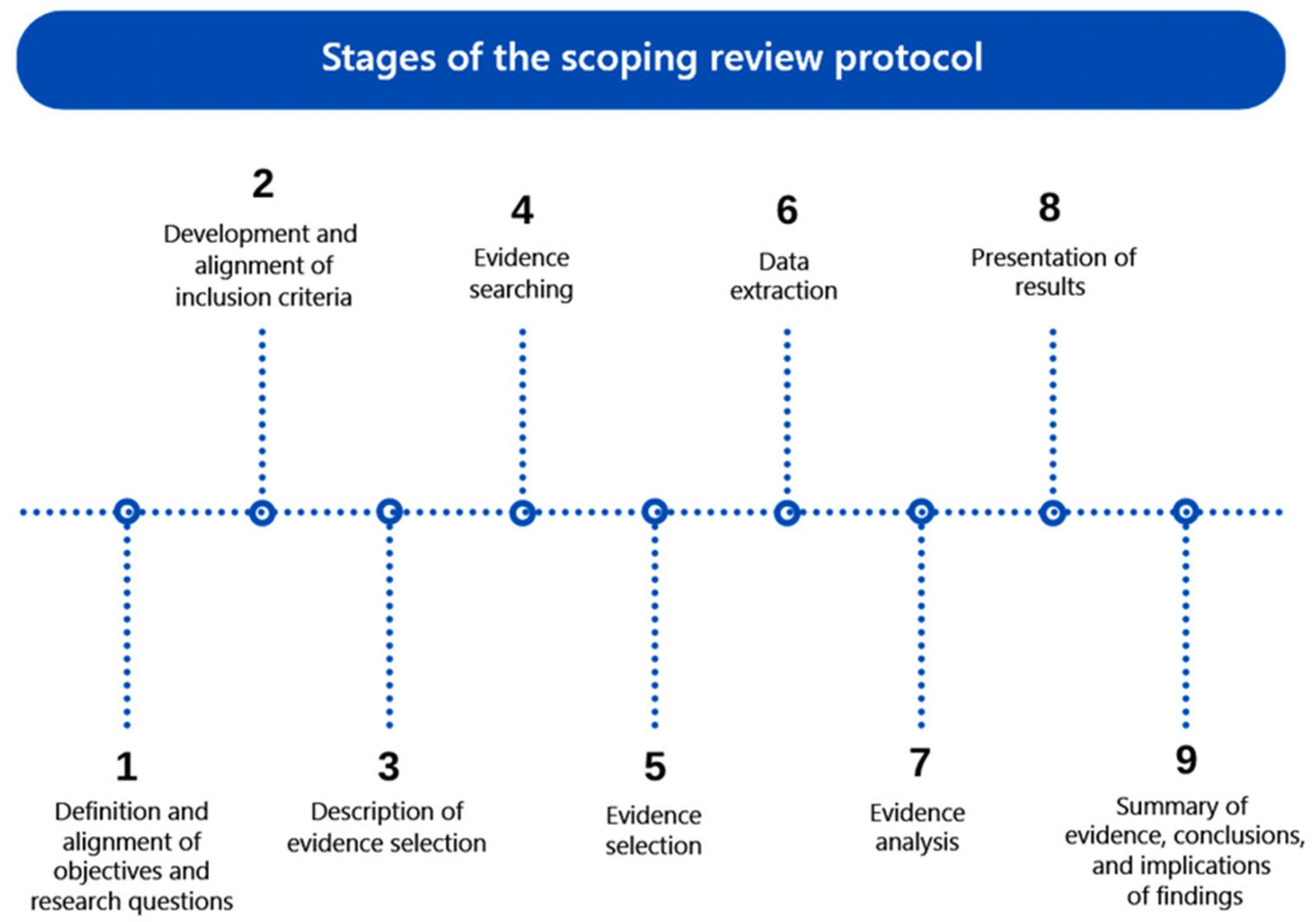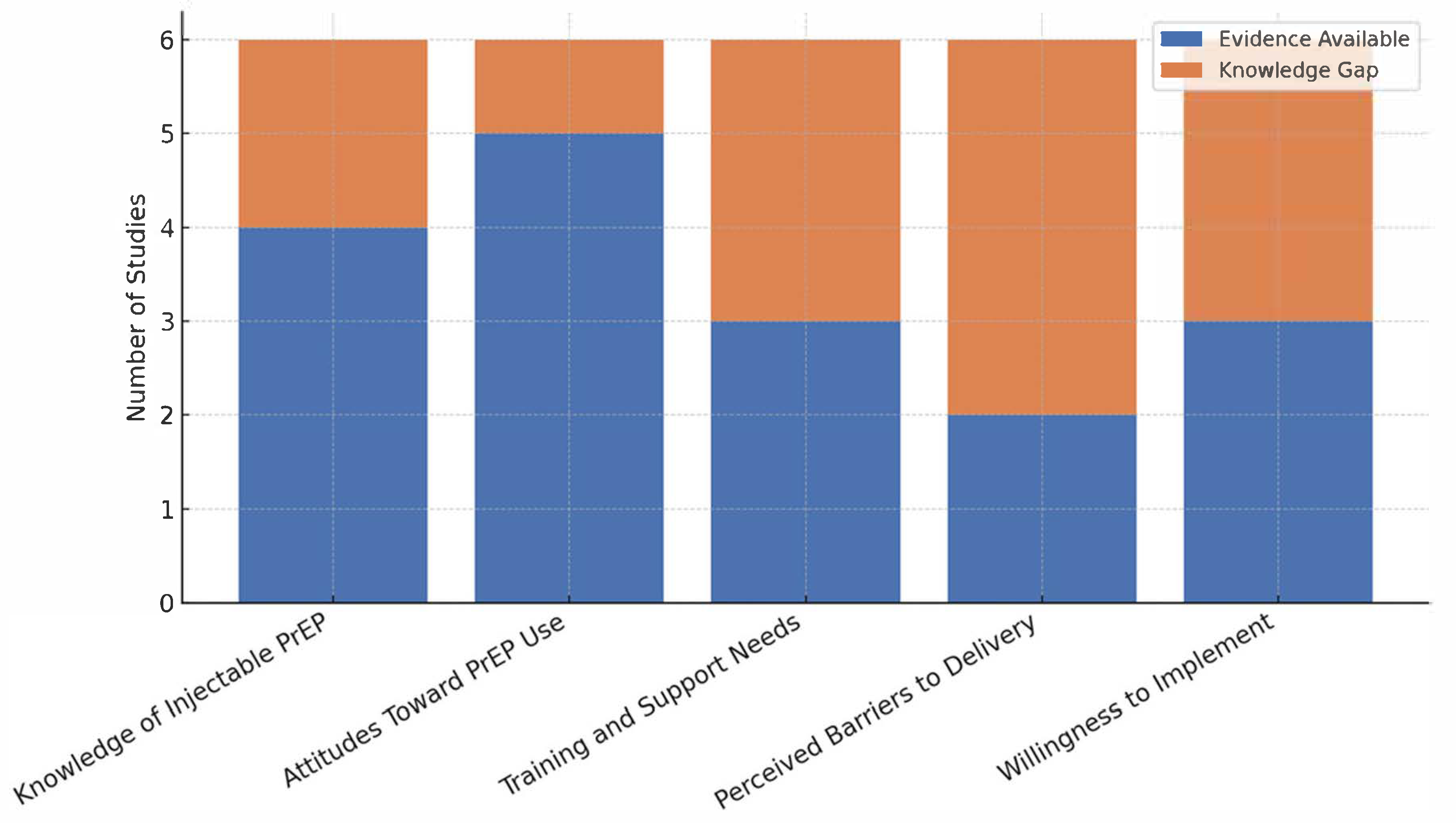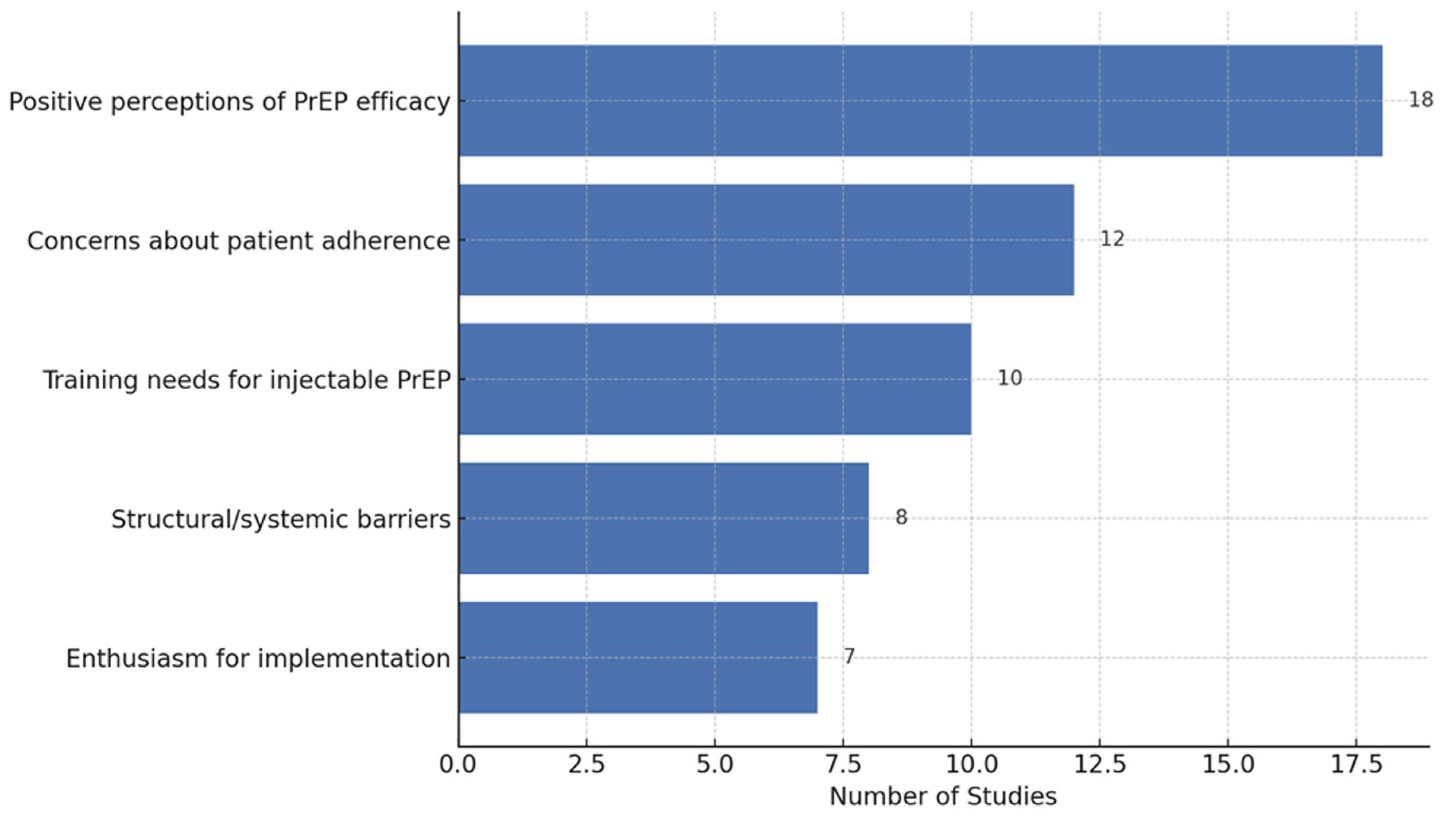Perspectives of Primary Healthcare Workers on HIV Injectable Pre-Exposure Prophylaxis (PrEP): A Scoping Review Protocol
Abstract
1. Introduction
1.1. Research Question
- What are healthcare workers’ perceptions regarding the acceptability of injectable PrEP among their patients?
- What challenges do healthcare workers face in recommending and administering injectable PrEP?
- What facilitators do healthcare workers identify that could enhance the implementation of injectable PrEP in clinical settings?
- What training and support mechanisms do healthcare workers believe are necessary for the effective delivery of injectable PrEP?
1.2. Objectives
1.3. Search Strategy
2. Methodology
2.1. Stage One: Definition and Alignment of Objectives and Research Questions
2.1.1. Review Questions
- What are healthcare workers’ perceptions regarding the acceptability of injectable PrEP among their patients?
- What challenges do healthcare workers face in recommending and administering injectable PrEP?
- What facilitators do healthcare workers identify that could enhance the implementation of injectable PrEP in clinical settings?
- What training and support mechanisms do healthcare workers believe are necessary for the effective delivery of injectable PrEP?
2.1.2. Search Strategy
2.1.3. Criteria for Selection of Search Terms
- Relevance to Population: Terms related to primary healthcare workers, such as “healthcare workers”, “attitude of health personnel”, and “primary health care workers”;
- Relevance to Concept: Terms related to perspectives on injectable PrEP, including “knowledge”, “awareness”, “attitudes”, “perceptions”, “implementation”, “barriers”, “facilitators”, “training”, and “support mechanisms”;
- Relevance to Context: Terms related to the healthcare settings in South Africa, ensuring the inclusion of studies conducted in relevant geographical and healthcare contexts.
2.1.4. Rationale for Database Selection
2.1.5. Presentation of Results
- Geographical Contexts: Urban versus rural settings, and different regions within South Africa;
- Healthcare Settings: Clinics, hospitals, community health centers, and public health programs;
- Socio-Cultural Contexts: Influence of local health policies, cultural attitudes toward HIV, and preventive measures.
2.2. Stage Two: Development and Alignment of Inclusion Criteria
2.3. Stage Three: Description of Evidence Selection
2.4. Stage Four: Evidence Searching
2.4.1. Screening Process
2.4.2. Eligibility Criteria
2.5. Step Five: Evidence Selection
2.6. Step Six: Data Extraction
2.7. Step Seven: Evidence Analysis
2.7.1. Thematic Analysis Process
- Familiarization with Data: Reviewers will read and re-read the data to become familiar with the content.
- Generating Initial Codes: Initial codes will be generated based on significant features of the data. These codes will be applied to the entire dataset.
- Searching for Themes: Codes will be collated into potential themes, gathering all data relevant to each potential theme.
- Reviewing Themes: Themes will be reviewed and refined to ensure they accurately represent the data. This may involve merging, splitting, or discarding themes.
- Defining and Naming Themes: Each theme will be clearly defined and named, capturing the essence of what the theme represents.
- Producing the Report: A detailed report will be produced, including thematic maps, narrative summaries, and illustrative quotes from the data.
2.7.2. Quality Appraisal
2.8. Step Eight: Presentation of Results
2.9. Step Nine: Summary of Evidence
- Highlight areas where perspectives are consistently reported across contexts (e.g., strong support for PrEP efficacy);
- Identify domains with limited or inconsistent evidence (e.g., training and capacity-building needs);
- Suggest priority areas for future primary research, particularly in underrepresented regions or settings;
- Inform policymakers and implementation planners about healthcare worker readiness and concerns regarding the injectable PrEP rollout.
3. Discussion
4. Conclusions
Author Contributions
Funding
Institutional Review Board Statement
Informed Consent Statement
Data Availability Statement
Conflicts of Interest
References
- Govender, R.D.; Hashim, M.J.; Khan, M.A.; Mustafa, H.; Khan, G. Global epidemiology of HIV/AIDS: A resurgence in North America and Europe. J. Epidemiol. Glob. Health 2021, 11, 296–301. [Google Scholar] [CrossRef]
- Biello, K.B.; Mimiaga, M.J.; Santostefano, C.M.; Novak, D.; Mayer, K.H. MSM at Highest Risk for HIV Acquisition Express Greatest Interest and Preference for Injectable Antiretroviral PrEP Compared to Daily, Oral Medication. AIDS Behav. 2018, 22, 1158–1164. [Google Scholar] [CrossRef] [PubMed]
- Spinelli, M.A.; Grinsztejn, B.G.J.; Landovitz, R.J. Promises and challenges: Cabotegravir for preexposure prophylaxis. Curr. Opin. HIV AIDS 2022, 17, 186–191. [Google Scholar] [CrossRef]
- Mantsios, A.; Murray, M.; Karver, T.S.; Davis, W.; Galai, N.; Kumar, P.N.; Swindells, S.; Bredeek, U.F.; García, R.R.; Antela, A.; et al. Multi-level considerations for optimal implementation of long-acting injectable antiretroviral therapy to treat people living with HIV: Perspectives of health care providers participating in phase 3 trials. BMC Health Serv. Res. 2021, 21, 255. [Google Scholar] [CrossRef] [PubMed]
- Abdool Karim, Q. Enhancing HIV Prevention with Injectable Preexposure Prophylaxis. New Engl. J. Med. 2021, 385, 652–653. [Google Scholar] [CrossRef]
- Rogers, B.G.; Chan, P.A.; Sutten-Coats, C.; Zanowick-Marr, A.; Patel, R.R.; Mena, L.A.; Goedel, W.C.; Chu, C.T.; Silva, E.; Galipeau, D.; et al. Perspectives on long-acting formulations of pre-exposure prophylaxis (PrEP) among men who have sex with men who are non-adherent to daily oral PrEP in the United States. BMC Public Health 2023, 23, 1643. [Google Scholar] [CrossRef] [PubMed]
- Valente, P.K.; Operario, D.; Rusley, J.C.; Bauermeister, J.A.; Biello, K.B. The need for a health equity framework in next-generation pre-exposure prophylaxis implementation. Lancet HIV 2023, 10, e266–e268. [Google Scholar] [CrossRef]
- Mayer, K.H.; Agwu, A.L.; Malebranche, D.J. Barriers to the Wider Use of Pre-exposure Prophylaxis in the United States: A Narrative Review. Adv. Ther. 2020, 37, 1778–1811. [Google Scholar] [CrossRef]
- Brennan-Ing, M.; Mattas, E. Aging with HIV: Working to Ensure Equity and Inclusion. Gerontology 2023, 69, 946–952. [Google Scholar] [CrossRef]
- Fonner, V.A.; Ridgeway, K.; van der Straten, A.; Lorenzetti, L.; Dinh, N.; Rodolph, M.; Schaefer, R.; Schmidt, H.-M.A.; Nguyen, V.T.T.; Radebe, M.; et al. Safety and efficacy of long-acting injectable cabotegravir as preexposure prophylaxis to prevent HIV acquisition. AIDS 2023, 37, 957–966. [Google Scholar] [CrossRef]
- Asabor, E.N.; Lett, E.; Moll, A.P.; Shenoi, S.V. “We’ve Got Our Own Beliefs, Attitudes, Myths”: A Mixed Methods Assessment of Rural South African Health Care Workers’ Knowledge of and Attitudes Towards PrEP Implementation. AIDS Behav. 2021, 25, 2517–2532. [Google Scholar] [CrossRef] [PubMed]
- Pike, C.; Rousseau, E.; Bekker, L.-G. Promises and potential pitfalls of long-acting injectable pre-exposure prophylaxis. South. Afr. J. HIV Med. 2023, 24, 1497. [Google Scholar] [CrossRef]
- Moyo, E.; Murewanhema, G.; Musuka, G.; Dzinamarira, T. Long-acting injectable drugs for HIV-1 pre-exposure prophylaxis: Considerations for Africa. Trop. Med. Infect. Dis. 2022, 7, 154. [Google Scholar] [CrossRef] [PubMed]
- Ahmed, N.; Pike, C.; Bekker, L.-G. Scaling up pre-exposure prophylaxis in sub-Saharan Africa. Curr. Opin. Infect. Dis. 2019, 32, 24–30. [Google Scholar] [CrossRef] [PubMed]
- Mutambo, C.; Hlongwana, K.W. Healthcare Workers’ Perspectives on the Barriers to Providing HIV Services to Children in Sub-Saharan Africa. AIDS Res. Treat. 2019, 2019, 8056382. [Google Scholar] [CrossRef]
- Thomas, T.L. Injectable PrEP superior to oral PrEP. Nat. Rev. Urol. 2021, 18, 576. [Google Scholar] [CrossRef]
- Marshall, B.D.; Goedel, W.C.; King, M.R.; Singleton, A.; Durham, D.P.; Chan, P.A.; Townsend, J.P.; Galvani, A.P. Potential effectiveness of long-acting injectable pre-exposure prophylaxis for HIV prevention in men who have sex with men: A modelling study. Lancet HIV 2018, 5, e498–e505. [Google Scholar] [CrossRef]
- Hodges-Mameletzis, I.; Dalal, S.; Msimanga-Radebe, B.; Rodolph, M.; Baggaley, R. Going global: The adoption of the World Health Organization’s enabling recommendation on oral pre-exposure prophylaxis for HIV. Sex. Health 2018, 15, 489–500. [Google Scholar] [CrossRef]
- Pleuhs, B.; Quinn, K.G.; Walsh, J.L.; Petroll, A.E.; John, S.A. Health Care Provider Barriers to HIV Pre-Exposure Prophylaxis in the United States: A Systematic Review. AIDS Patient Care STDs 2020, 34, 111–123. [Google Scholar] [CrossRef]
- Bleasdale, J.; McCole, M.; Cole, K.; Hequembourg, A.; Morse, G.D.; Przybyla, S.M. Perspectives on Injectable HIV Pre-Exposure Prophylaxis: A Qualitative Study of Health Care Providers in the United States. AIDS Patient Care STDs 2024, 38, 177–184. [Google Scholar] [CrossRef]
- Mahlare, E.; Ramutshila, M.E.; Musekiwa, M.A.; Kuonza, P.L.; MB ChB, M.; Mabuto, T. Knowledge, attitudes and practices of oral HIV pre-exposure prophylaxis (PrEP) among healthcare workers in the Ekurhuleni District, South Africa. South Afr. Med. J. 2023, 113, 46. [Google Scholar] [CrossRef]
- Monera, T.; Ncube, P. Assessment of knowledge, attitudes and practices of healthcare workers on occupational HIV post-exposure prophylaxis at a Zimbabwean referral hospital. J. Int. AIDS Soc. 2012, 15, 523–530. [Google Scholar]
- Zhang, L.; Song, Y.; Zheng, X.; Liu, Y.; Chen, H. The experience of healthcare workers to HIV pre-exposure prophylaxis (PrEP) implementation in low- and middle-income countries: A systematic review and qualitative meta-synthesis. Front. Public Health 2023, 11, 1224461. [Google Scholar] [CrossRef]
- Pinto, R.M.; Berringer, K.R.; Melendez, R.M.; Mmeje, O. Improving PrEP Implementation Through Multilevel Interventions: A Synthesis of the Literature. AIDS Behav. 2018, 22, 3681–3691. [Google Scholar] [CrossRef]
- Durham, S.H.; Milam, A.; Waer, D.; Chahine, E.B. Cabotegravir: The first long-acting injectable for HIV preexposure prophylaxis. Ann. Pharmacother. 2023, 57, 306–316. [Google Scholar] [CrossRef]
- Liégeon, G.; Delaugerre, C.; Molina, J.-M. HIV Pre-exposure Prophylaxis. Infect. Dis. Clin. North Am. 2024, 38, 453–474. [Google Scholar] [CrossRef]
- PRISMA Extension for Scoping Reviews (PRISMA-ScR): Checklist and Explanation. Ann. Intern. Med. 2018, 169, 467–473. [CrossRef]




| Mnemonic Elements | Concepts | Definition |
|---|---|---|
| Population | Primary healthcare workers | Healthcare workers are involved in HIV prevention, treatment, and care. This could include doctors, nurses, pharmacists, and public health professionals who interact with patients regarding HIV prevention methods. We include doctors, who diagnose and treat illnesses, prescribe medications, and provide preventive care; nurses, who provide patient care, administer medications, and support patient education and preventive measures; pharmacists, who dispense medications, provide medication counseling, and support patient adherence to prescribed treatments; community health workers, who provide basic health and medical care within the community, often focusing on preventive care and health education; and public health professionals, who work on health promotion, disease prevention, and health policy implementation at the community or population level. By explicitly defining these roles, we ensure clarity and comprehensiveness in identifying and analyzing the perspectives of primary healthcare workers on HIV injectable PrEP. |
| Concept | Perspectives of healthcare workers on HIV Injectable PrEP, including their attitudes, beliefs, knowledge, challenges, and experiences | Perspectives encompass attitudes, beliefs, knowledge, challenges, and experiences of healthcare workers concerning Injectable Pre-Exposure Prophylaxis (PrEP) for HIV prevention. This includes their knowledge about PrEP, willingness to prescribe, perceived effectiveness, barriers to implementation, and overall support for PrEP among their patients. |
| Context | The healthcare setting where HIV Injectable PrEP is being implemented, such as clinics, hospitals, community health centers, or public health programs | The setting in which healthcare workers operate which may include hospitals, clinics, community health centers, and public health programs. It might also involve considerations of geographical location, such as urban versus rural settings, and the influence of local health policies and cultural attitudes toward HIV and preventive measures. |
| Search Number | Query | Sort By | Search Details | Results | Time |
|---|---|---|---|---|---|
| 4 | ((“primary healthcare workers” OR “healthcare personnel” OR “health workers” OR “nurses”[Mesh] OR “clinicians” OR “health personnel”[Mesh]) AND (“perspectives” OR “attitudes”[Mesh] OR “beliefs” OR “perceptions” OR “views” OR “knowledge”[Mesh] OR “awareness” OR “experience*” OR “barrier*” OR “challenge*” OR “facilitator*”) AND (“HIV”[Mesh] OR “HIV infections”[Mesh] OR “human immunodeficiency virus”) AND (“injectable PrEP” OR “long-acting PrEP” OR “cabotegravir” OR “CAB-LA” OR “Pre-Exposure Prophylaxis”[Mesh]) AND (“healthcare setting*” OR “clinics” OR “hospitals” OR “community health centre*” OR “primary health care”[Mesh] OR “public health program*”)) | Most Recent | (“primary healthcare workers”[All Fields] OR “healthcare personnel”[All Fields] OR “health workers”[All Fields] OR “nurses”[MeSH Terms] OR “clinicians”[All Fields] OR “health personnel”[MeSH Terms]) AND (“perspectives”[All Fields] OR “beliefs”[All Fields] OR “perceptions”[All Fields] OR “views”[All Fields] OR “knowledge”[MeSH Terms] OR “awareness”[All Fields] OR “experience*”[All Fields] OR “barrier*”[All Fields] OR “challenge*”[All Fields] OR “facilitator*”[All Fields]) AND (“HIV”[MeSH Terms] OR “HIV infections”[MeSH Terms] OR “human immunodeficiency virus”[All Fields]) AND (“injectable PrEP”[All Fields] OR “long-acting PrEP”[All Fields] OR “cabotegravir”[All Fields] OR “CAB-LA”[All Fields] OR “Pre-Exposure Prophylaxis”[MeSH Terms]) AND (“healthcare setting*”[All Fields] OR “clinics”[All Fields] OR “hospitals”[All Fields] OR “community health centre*”[All Fields] OR “primary health care”[MeSH Terms] OR “public health program*”[All Fields]) | 73 | 09:51:59 |
| 3 | ((“primary healthcare workers” OR “healthcare personnel” OR “health workers” OR “nurses”[Mesh] OR “clinicians” OR “health personnel”[Mesh]) AND (“perspectives” OR “attitudes”[Mesh] OR “beliefs” OR “perceptions” OR “views” OR “knowledge”[Mesh] OR “awareness” OR “experience*” OR “barrier*” OR “challenge*” OR “facilitator*”) AND (“HIV”[Mesh] OR “HIV infections”[Mesh] OR “human immunodeficiency virus”) AND (“injectable PrEP” OR “long-acting PrEP” OR “cabotegravir” OR “CAB-LA” OR “Pre-Exposure Prophylaxis”[Mesh]) AND (“healthcare settings” OR “clinics” OR “hospitals” OR “community health centres” OR “primary health care”[Mesh] OR “public health programs”) AND (“South Africa”[Mesh] OR “South Africa”)) | Most Recent | (“primary healthcare workers”[All Fields] OR “healthcare personnel”[All Fields] OR “health workers”[All Fields] OR “nurses”[MeSH Terms] OR “clinicians”[All Fields] OR “health personnel”[MeSH Terms]) AND (“perspectives”[All Fields] OR “beliefs”[All Fields] OR “perceptions”[All Fields] OR “views”[All Fields] OR “knowledge”[MeSH Terms] OR “awareness”[All Fields] OR “experience*”[All Fields] OR “barrier*”[All Fields] OR “challenge*”[All Fields] OR “facilitator*”[All Fields]) AND (“HIV”[MeSH Terms] OR “HIV infections”[MeSH Terms] OR “human immunodeficiency virus”[All Fields]) AND (“injectable PrEP”[All Fields] OR “long-acting PrEP”[All Fields] OR “cabotegravir”[All Fields] OR “CAB-LA”[All Fields] OR “Pre-Exposure Prophylaxis”[MeSH Terms]) AND (“healthcare settings”[All Fields] OR “clinics”[All Fields] OR “hospitals”[All Fields] OR “community health centres”[All Fields] OR “primary health care”[MeSH Terms] OR “public health programs”[All Fields]) AND (“South Africa”[MeSH Terms] OR “South Africa”[All Fields]) | 6 | 09:50:10 |
| 2 | ((“primary care” OR “primary healthcare” OR “primary health care” OR “community health services”[Mesh]) AND (“healthcare workers” OR “health workers” OR “health personnel”[Mesh] OR “nurses”[Mesh] OR “clinicians”)) AND ((“HIV”[Mesh] OR “HIV infections”[Mesh] OR “human immunodeficiency virus”) AND (“Pre-Exposure Prophylaxis” OR “injectable PrEP” OR “long-acting PrEP” OR “cabotegravir” OR “CAB-LA”)) AND ((“perceptions” OR “perspectives” OR “attitudes” OR “views” OR “knowledge” OR “awareness” OR “implementation experience” OR “barriers” OR “facilitators”)) | Most Recent | (“primary care”[All Fields] OR “primary healthcare”[All Fields] OR “primary health care”[All Fields] OR “community health services”[MeSH Terms]) AND (“healthcare workers”[All Fields] OR “health workers”[All Fields] OR “health personnel”[MeSH Terms] OR “nurses”[MeSH Terms] OR “clinicians”[All Fields]) AND ((“HIV”[MeSH Terms] OR “HIV infections”[MeSH Terms] OR “human immunodeficiency virus”[All Fields]) AND (“Pre-Exposure Prophylaxis”[All Fields] OR “injectable PrEP”[All Fields] OR “long-acting PrEP”[All Fields] OR “cabotegravir”[All Fields] OR “CAB-LA”[All Fields])) AND (“perceptions”[All Fields] OR “perspectives”[All Fields] OR “attitudes”[All Fields] OR “views”[All Fields] OR “knowledge”[All Fields] OR “awareness”[All Fields] OR “implementation experience”[All Fields] OR “barriers”[All Fields] OR “facilitators”[All Fields]) | 92 | 09:43:17 |
| 1 | (“Primary Health Care”[Mesh] OR “Health Personnel”[Mesh] OR “healthcare workers” OR “health care providers” OR “nurses” OR “clinicians”) AND (“HIV”[Mesh] OR “Human Immunodeficiency Virus”) AND (“Pre-Exposure Prophylaxis”[Mesh] OR “injectable PrEP” OR “long-acting PrEP” OR “cabotegravir” OR “CAB-LA”) AND (“Attitude of Health Personnel”[Mesh] OR “perception” OR “perspective” OR “knowledge” OR “awareness” OR “experience” OR “acceptability” OR “barriers” OR “facilitators”) | Most Recent | (“Primary Health Care”[MeSH Terms] OR “Health Personnel”[MeSH Terms] OR “healthcare workers”[All Fields] OR “health care providers”[All Fields] OR “nurses”[All Fields] OR “clinicians”[All Fields]) AND (“HIV”[MeSH Terms] OR “Human Immunodeficiency Virus”[All Fields]) AND (“Pre-Exposure Prophylaxis”[MeSH Terms] OR “injectable PrEP”[All Fields] OR “long-acting PrEP”[All Fields] OR “cabotegravir”[All Fields] OR “CAB-LA”[All Fields]) AND (“Attitude of Health Personnel”[MeSH Terms] OR “perception”[All Fields] OR “perspective”[All Fields] OR “knowledge”[All Fields] OR “awareness”[All Fields] OR “experience”[All Fields] OR “acceptability”[All Fields] OR “barriers”[All Fields] OR “facilitators”[All Fields]) | 62 | 09:09:50 |
| Title of the study |
| Author and year of publication |
| keywords |
| Study location |
| Study sector/setting |
| Study Aim |
| Study design |
| Study population(Primary healthcare managers, HIV nurses, HIV Counselling and Testing counsellors, and health promoters above 18) |
| Findings |
| Conclusion |
| Study ID | Author(s), Year | Country | Study Design | Healthcare Workers | Setting | Key Findings Related to Perspective |
|---|---|---|---|---|---|---|
| 001 | Smith et al., 2021 | Kenya | Qualitative | Nurses, CHWs | Rural Clinic | Positive attitudes but limited training |
| 002 | Zhang et al., 2022 | USA | Mixed methods | Physicians, Nurses | Urban Hospital | Concern about long-term adherence |
| 003 | Nguyen et al., 2023 | Vietnam | Quantitative | Nurses | Community Health Center | Supportive but unclear guidelines |
Disclaimer/Publisher’s Note: The statements, opinions and data contained in all publications are solely those of the individual author(s) and contributor(s) and not of MDPI and/or the editor(s). MDPI and/or the editor(s) disclaim responsibility for any injury to people or property resulting from any ideas, methods, instructions or products referred to in the content. |
© 2025 by the authors. Licensee MDPI, Basel, Switzerland. This article is an open access article distributed under the terms and conditions of the Creative Commons Attribution (CC BY) license (https://creativecommons.org/licenses/by/4.0/).
Share and Cite
Mbatha, N.N.; Mpofana, N.; Gumede, D. Perspectives of Primary Healthcare Workers on HIV Injectable Pre-Exposure Prophylaxis (PrEP): A Scoping Review Protocol. Int. J. Environ. Res. Public Health 2025, 22, 830. https://doi.org/10.3390/ijerph22060830
Mbatha NN, Mpofana N, Gumede D. Perspectives of Primary Healthcare Workers on HIV Injectable Pre-Exposure Prophylaxis (PrEP): A Scoping Review Protocol. International Journal of Environmental Research and Public Health. 2025; 22(6):830. https://doi.org/10.3390/ijerph22060830
Chicago/Turabian StyleMbatha, Nomvuselelo Nomzamo, Nomakhosi Mpofana, and Dumile Gumede. 2025. "Perspectives of Primary Healthcare Workers on HIV Injectable Pre-Exposure Prophylaxis (PrEP): A Scoping Review Protocol" International Journal of Environmental Research and Public Health 22, no. 6: 830. https://doi.org/10.3390/ijerph22060830
APA StyleMbatha, N. N., Mpofana, N., & Gumede, D. (2025). Perspectives of Primary Healthcare Workers on HIV Injectable Pre-Exposure Prophylaxis (PrEP): A Scoping Review Protocol. International Journal of Environmental Research and Public Health, 22(6), 830. https://doi.org/10.3390/ijerph22060830







